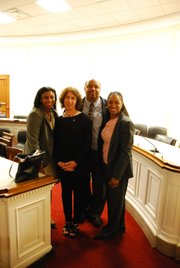With the summer swimming season just about to kick off, the excitement of a freshly opened pool or beach may cause eagerly returning patrons to forget their number one priority as patrons: safety.
On Wednesday, May 15, a congressional briefing recognizing International Water Safety Day—organized in part by Burke swim coach and teacher and Alexandria resident Miriam Lynch—brought together executives from a variety of professional aquatic organizations to discuss their individual and shared efforts to better educate people about water safety.
THE STATISTICS ON DROWNING are staggering: According to the World Health Organization, roughly 388,000 people worldwide perish that way each year, good for the third leading cause of all unintentional injury-related death. For the United States alone, the CDC reported 3,533 drowning deaths annually from 2005-2009. These are consistently epidemic numbers.
May is National Water Safety Month, a distinction brought about by the Association of Pool & Spa Professionals (APSP), the American Red Cross, the National Recreation & Park Association (NRPA), and the World Waterpark Association (WWA). While the message of safety is admirable, Lynch believes it falls short of inspiring people to act, and actively educate others about water safety.
“There aren’t any activities,” said Lynch, an Alexandria resident and personal finance and accounting teacher at Lake Braddock Secondary School. “Nobody gets riled up and excited for Water Safety Month. Nobody has programs.”
Teaching may be her day job, but the former standout swimmer and coach for both Lake Braddock and Howard University divides her down time among all things aquatic. As a senior-level coach at the Burke site of the Nation’s Capital Swim Club; division and inclusion coordinator for the USA Swimming Eastern Zone; member of the non-profit Diversity in Aquatics; and a seat on the USA Swimming National Committee on Diversity and Inclusion, she is fully integrated in a number of both local and national swimming communities.
SEEING A NEED for more action in spreading education and awareness of water safety, Lynch engaged with like-minded peers including Shaun Anderson, one of the founders of Diversity in Aquatics, to create the push for an International Water Safety Day. In her words, it is “a specific day where different aquatic professional organizations could come together and say, ‘Here are some tools. Let’s go out there and make kids water-safe.’”
But to get traction, to get these organizations to buy in, there would need to be recognition from the top down. With help from US Representatives Chaka Fattah (D-Pennsylvania) and Howard Coble (R-North Carolina), sponsor and co-sponsor, respectively, HR.79 was introduced, acknowledging May 15 as International Water Safety Day. The resolution passed early in 2012, and “went live” for the first time later that year, according to Lynch.
“That was big for us,” she said. “That legitimizes the day. It’s not just an idea. Now we have people who stand behind it, policy-makers in the House.”
THIS YEAR was about bringing together like-minded groups that would not otherwise have communicated or networked to this degree. “Say the National Drowning Prevention Alliance is going to do something for Water Safety Month,” said Lynch, “but they’re not talking to Red Cross, who might also be doing something. Why are we trying to do things on our own, instead of all coming together?”
To that end, Lynch and her colleagues were able to corral nearly a dozen different organization representatives at a congressional hearing in the Rayburn House office building on May 15.
Among these were Wanda Butts from the Josh Project charitable swim instruction organization, Henry Reyes from the International Surf and Life Saving Association, Connie Harvey of the American Red Cross, Kevin McCartney of the Boys & Girls Clubs of America, and Debbie Hesse of the USA Swimming Foundation. “What was great and powerful was that many of them did come together, and now they’re starting to speak,” said Lynch.
Now that International Water Safety Day has broken through the top layer of information distribution, Lynch says the focus rests firmly on getting as much information to as many people as possible. “I wish we had more people from the community [at the briefing],” she said. “The challenge is to get people who are willing to do things on the community level.”
Lynch herself has organized and executed two different Water Safety Day events in Washington, D.C., but has found it difficult to work out startup or one-off deals with host pools in Northern Virginia. Regardless, she encourages her older swimmers to become involved in existing safety programs, such as the “Nadar Por Vida” lessons for Latino and/or low income youth, held at Providence Recreational Center in Falls Church.
“I tell them, ‘be empowered, do this,’” she said. “Why do community service at a food bank? While it’s good, use your skills that you possess to help others.”
Disseminating water safety education is one crucial way to prevent drowning deaths, according to Lynch. And developing a curriculum to be brought into schools is the next phase for International Water Safety Day.
“In my own family,” reflected Lynch, “my mom had a brother who drowned, I had a friend who drowned. You get nuzzled in your own world—these are my own tragedies. But to hear how bad they are outside of the circle. ... It’s just senseless stuff. If you just knew...”
For more information, visit www.internationalwatersafetyday.org.
